Merry Christmas and Happy Holidays
On that positive note, let us say a not so fond farewell to this awful year, 2020.
But it has been sunny for several days, reminding us of better times.
Remember better times. That is both a question and I suppose a directive. Try to come up with the proper punctuation for that.
We have stayed put this year. We stayed in our house. Of course when I say 'this year' I mean for this holiday season. But actually I also mean forever. Well, not quite forever. But for a lot of forever.
Yesterday, as the temperatures soared to above freezing, we did go look at eagles again, out by the dam north of Iowa City. There were many. Some of you may even have been there yesterday too.
We even found a nest. It is on the west side of the river, right down the path along the river.
The nest was in a big cottonwood tree, almost right over the path. After you had seen the nest you could see the consequences of the nest, right there on the path.
Here is the picture. The next is a little hard to see.
It really was amazing how warm 36 degrees was, with the sun out and no wind.
But let us talk pictures of flowers.
Last Week- Week #4
The winner was... the blue iris.
The voting was close all week. The iris went ahead by the final one vote margin, about mid week.
Here was the final vote total:
The daffodil, with that strong second place finish, puts itself in a good place for getting one of the wild card entries in the playoffs. It really was a nice picture of a daffodil.
This Week- Week 5
I have a great group of contestants this week. As I try to plan it out, I always try to create a balanced field. Sometimes people have commented on Sunday as to which picture they like, but also what they think will be the order of finish. That can be fun. I will not tell you my thoughts, to avoid any prejudice to the voting. I would tell my thoughts in a comment if any wish to participate in such conjecture.
#1 Winter aconite
March 5, 2020
I have started growing calla lilies again. I grew them maybe 20 years ago. You have to bring the bulbs inside like you do with dahlias or cannas. (I grow neither of those plants. You have to draw some lines.) I must have overwintered them for 5-10 years, until something went wrong one winter. Memory has blurred that bad event. Maybe they froze in the garage. Whatever. Stuff happens.
But in 2019 I got some new ones. In 2020 they were bigger and better. I still am waiting for the really big white ones. But this purple one was rather grand.
There you have the quite diverse contestants for this week. Which one do you like and why?
Bonus pictures
Aconite, also called Winter Wolf's Bane
Enjoy these aconite pictures. The dates are with each picture.
I love this next picture for several reasons. First I love the brown background for the early spring bulbs. In all that brown there is always such interesting features with various pieces of garden debris.
I also like how these first bulbs are so solitary.
 |
| February 15 |
Here is that same flower, only a week later it had decided it would bloom.
 |
| February 22 You can see the various stages of the plant in this picture. It comes out of the ground with its head down. Then it raises it up, looking for the sun. |
 |
| February 23 |
They come up all over. They grow in the paths, along with some bluebells and the occasional crocus. I did not plant them there. They are the first to be transplanted to places needing more bulbs.
 |
| February 29 |
 |
| March 4 |
Here is an enlargement of the flower. Did I mention it does not taste good? Tasty plants have a hard time in the evolutionary jungle.
 |
| March 17 |
In this picture as you can see the generations. The first generation will not bloom that first year.
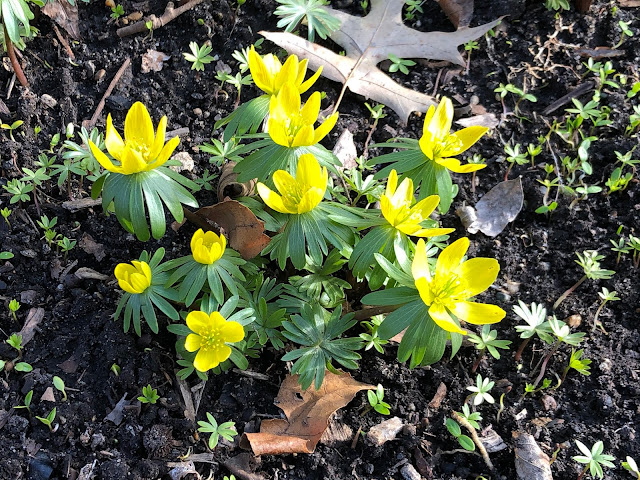 |
| March 17 |
They become a carpet. At that point you can start moving some of them to parts of the garden that need some color. If you move them before the plant is too large, they will not even wilt at all.
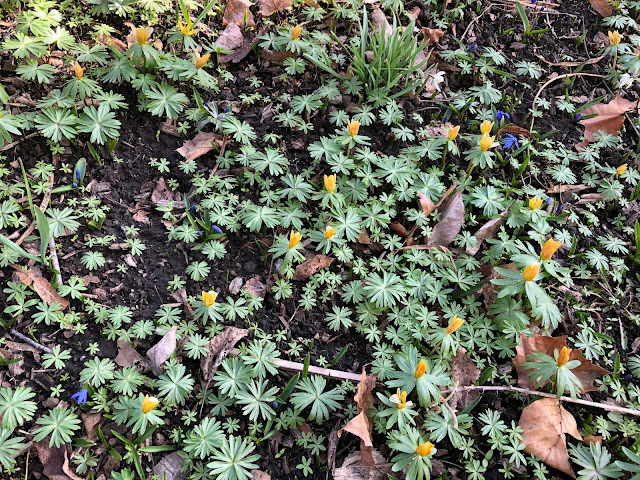 |
| March 17 |
Calla lilies
Here are the bulbs really ready to go on April 26. There are several varieties there. You can see some are already making big bulbs, and some are not.Here is a clump in the fall. I dug them in October, before the frost killed the leaves. I let them dry and then stored them in peat moss for the winter.
Right Now
This is the new orchid that we have been waiting for it to bloom for several weeks. It is close at the moment.
After eagle watching yesterday afternoon we picked up sticks in the yard. Sticks can multiply almost as much as leaves.
While doing that I looked down. There was a little fall crocus gamely trying to get enough sun to open. Not quite and more cold and snow will be coming. Maybe tomorrow if the sun stays out.
Julia's recipe
Frittata
Frittata is a fancy flat omelette. Maybe you knew that. A frittata is a good choice when you have a little more time and are prepared to make a little bigger effort than required for an omelette or scrambled eggs. A frittata is prettier and therefore more festive. Festivity in all areas has been at a premium this year. This recipe is from the Joshua McFadden cookbook (Six Seasons) that has been a go-to this year. It is from the chapter celebrating bell peppers, although there are other supporting player-vegetables as well.
The ingredients: 2 cups bell peppers cut into little strips; 1 cup of diced potatoes (I used Yukon Gold from the farmer's market which were small and thin-skinned so did not require peeling); 4 oz. prosciutto, sliced (or deli ham - more on this below); 1/2 cup of sliced scallions; 1/2 cup of parmesan cheese; 2 tablespoons butter; about 1/2 cup ricotta cheese; 6 eggs; kosher salt and pepper.
Some times I have more time and patience for garden stuff than others. This is not any major insight.
For example if I am busy with weeding or watering I may not have the time to carefully stake certain plants that could use it.
In the winter time the gardening time demands are minimal. I have to water plants. I need to check for bugs. (Yes, they do show up in the winter. Mealy bugs can be a persistent with some plants. ) In the winter I also start plants from cuttings.
At some point I engage in seed work. It is now that time of year.
Seed work starts with obtaining the seed. I have some old faithful plants I regularly grow from seed. Iceland poppies and lupines are two in that group. They both germinate in about a week. They do nicely under lights. They can go outside early in the year. My target date to plant them is January 1.
I am on schedule.
There are so many other plants you see in the catalogues. I sometimes just like to try things new. Of course you do not see the instructions when you see the plants in the catalogues. Sometimes it says germination might take 60 days. Keeping track of the planted dirt for that long is a real task.
This last few days I had some time available. (That means a spare hour.) Someone had given me some colchicum seeds. Fall crocuses. Remember them? Wonderful plants. I buy bulbs. Bulbs grow from seeds. The person had thought he was ordering bulbs and got seeds instead. Sometimes mail order nurseries will sell both. It can be confusing. Remember, if you are buying anything for $3 it would be seeds.
So he asked if I would be interested in trying the seeds. I said sure.
So I read the instructions. I looked on the packet and went online. The first thing I noticed was the part about how germination could take two years. Oh my. There was also the part where the seeds needed to be cold for a while. Plant them and put them outside for the winter. How cold? Did the nursery know how cold Iowa gets in the winter. Do you water them first?
I then decided this would be an experiment. I planted all 40 seeds in two shallow pots. I watered them. One pot went to the inside garage. I figure it would be between 15- 45 degrees most of the winter. Another pot went to the back garage. Neither garage is heated. But the back garage would be 10 degrees above whatever the outside would be. I will check them maybe once a month, if I remember. I did put a little label with them with the name and the date planted.
Sometimes artsy happens, by accident. I had not intended to take this picture in black and white. You can see eagles across the river.
Moving away from artsy, it is now pumpkin time. Watch for them. They are in the walnut tree.















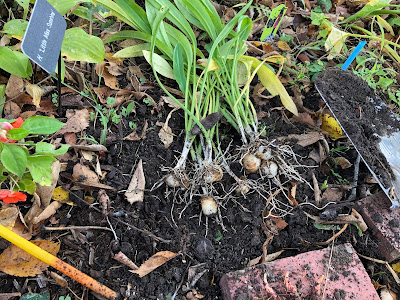




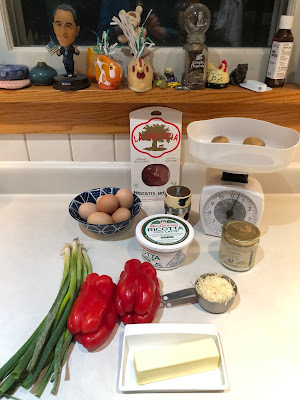










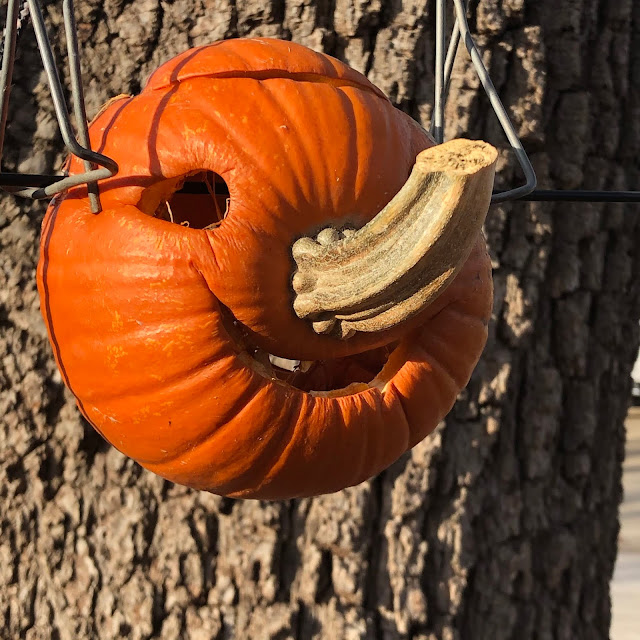
3 comments:
I voted for the calla lily because of (1) the color, and (2) the structure of the bloom. So elegant.
Love the aconite pictures, especially the one growing out of a brick.
The fritatta is just up my alley. Give me that, some buttered rye toast, and coffee, and I'm happy!
Gee, from your description, I guess my taste is mundane, but I voted for the white Iceland Poppy, and so far it was the easiest choice of this year's contest. To thine own self be true and all 'dat.
2021 will be better.
Pat- I am so glad I started growing calla lilies again. I do hope I can grow the big white ones. Do any of the spring bulbs grow in the south?
Dave- I also voted for the Iceland poppy. I thought it might be in a class of its own. There are two more Iceland poppies yet to come. They certainly are special. I did think there was good support all the way down to 5th place.
Thank you both for your comments.
Post a Comment